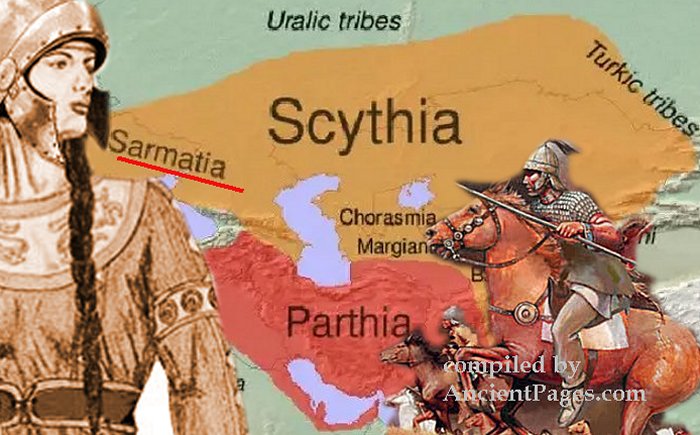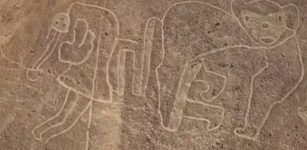Amage: Sarmatian Warrior Queen/Regent Who Impressed With Remarkable Military Skills
A. Sutherland - AncientPages.com - Multiple burials of possible women warriors have been unearthed in sites associated with the Scythians, Sauromatians (a tribe nation ruled by women), and Sarmatians.
These ancient cultures from the late seventh through the second centuries BC had many female warriors.
 Among many women who lived in this part of the world, and roamed wild Scythian steppes, was Amage, a Sarmatian warrior queen who lived at the end of the 2nd century BC.
Among many women who lived in this part of the world, and roamed wild Scythian steppes, was Amage, a Sarmatian warrior queen who lived at the end of the 2nd century BC.
Many excavated Sarmatian military burials include the remains of armed Sarmatian women. The remains reveal clear signs of severe battle injuries, including stabs to their skulls and blows, similar to those observed on the remains of male warriors.
These findings, along with spears, axes, lances, and even double-edged short-swords (akinakes), found in the graves, strongly suggest that they all died in battle. The Sarmatian women, as were their husbands, brothers, and other relatives, were brave and skilled.
Among many women who lived in this part of the world, and roamed wild Scythian steppes, was Amage, a Sarmatian warrior queen who lived at the end of the 2nd century BC. She was the wife and co-ruler of the Sarmatian king Medosacus. Otherwise, very little is known about this Sarmatian queen and her rule. However, Sarmatian women became famous for having a prominent role in wars.
According to Hippocrates (c. 460 – c. 370 BC), Sarmatian women participated in warfare, and Herodotus (c. 484 – c. 425 BC), a Greek historian, described them as fighting in the same clothing as men. Some believe that the deeds of Amage's and other Sarmatian female warriors inspired those who created the Greek myths of the Amazons.
According to one source, her husband was a notorious drunkard who abused his power as a monarch for personal luxury. At the same time, another version points to the king's mental incompetence.
Amage Made An Important Decision In Difficult Times
From now on, the brave queen-warrior acted as regent; she took over the government into her own hands.
Polyaenus, a 2nd-century AD Macedonian author, writes in "Stratagems:
"She judged causes, stationed garrisons, repulsed the invasions of enemies, and directed everything with such a great ability that her fame extended through all Scythia."
She Was A Successful Ruler
Amage was impressed with the extraordinary military achievements - in the era of big but sluggish armies which depended more on size than strategy and tactics.
Instead, she organized a rally reminiscent of the actions of modern commandos. Her fame as a successful leader reached neighboring tribes and even far beyond the borders of her territories.
The inhabitants of the Chersonesus (once an ancient Greek colony founded about 2,500 years ago in the southwestern part of the Crimean Peninsula) also learned about her achievements. A king of the neighboring Scythians had systematically harassed these people. At last, they requested an alliance with her.
Polyaenus narrates that "in consequence of a treaty formed between the two nations, she wrote to the Scythian prince, requesting him not to repeat his ravages in the Chersonesus. When he treated her prohibition with disrespect, she marched against him with a hundred and twenty men of tried courage, and extraordinary strength, each of them provided with three horses."
In one night and day, she covered about two hundred kilometers (versions vary) and reached the enemy's palace.
In an unexpected attack, her troops captured the prince's palace, slew the guards, his friends, and his family, and ultimately killed the ruler.
Then "she put the inhabitants of Chersonesus back in free possession of their country, and gave his hereditary dominions to the son of the Scythian prince."
She allowed his son to live on the condition that he obeys her. She also warned him to be careful and take "a warning from his father's death, and not to invade the territories of the neighboring Greeks and barbarians."
Written by - A. Sutherland - AncientPages.com Senior Staff Writer
Updated on May 20, 2023
Copyright © AncientPages.com All rights reserved. This material may not be published, broadcast, rewritten or redistributed in whole or part without the express written permission of AncientPages.com
Expand for referencesReferences:
Mayor, Adrienne. The Amazons (p. 372). Princeton University Press.
Polyaenus: Stratagems
More From Ancient Pages
-
 On This Day In History: Storming Of The Paris Fortress – Prison Bastille – On July 14, 1789
News | Jul 14, 2016
On This Day In History: Storming Of The Paris Fortress – Prison Bastille – On July 14, 1789
News | Jul 14, 2016 -
 Fossil Bones From The Largest Penguin That Ever Lived Unearthed In New Zealand
Fossils | Feb 10, 2023
Fossil Bones From The Largest Penguin That Ever Lived Unearthed In New Zealand
Fossils | Feb 10, 2023 -
 Rare Minoan Sealstone Is A Miniature Masterpiece Unearthed In 3,500-Year-Old Tomb Of Powerful Mycenaean Warrior
Archaeology | Nov 8, 2017
Rare Minoan Sealstone Is A Miniature Masterpiece Unearthed In 3,500-Year-Old Tomb Of Powerful Mycenaean Warrior
Archaeology | Nov 8, 2017 -
 Cyclopean Fortress Of Sacsayhuamán – ‘Impossible’ Ancient Technology In Peru
Featured Stories | Apr 10, 2017
Cyclopean Fortress Of Sacsayhuamán – ‘Impossible’ Ancient Technology In Peru
Featured Stories | Apr 10, 2017 -
 Ahimsa – Ancient Non-Violence Concept Teaching Compassion And Love Towards All Living Beings
Featured Stories | Jan 2, 2019
Ahimsa – Ancient Non-Violence Concept Teaching Compassion And Love Towards All Living Beings
Featured Stories | Jan 2, 2019 -
 Ancient Roman Shipwreck Marausa 2 With Intact Cargo Recovered Off The Coast Of Sicily
Archaeology | Oct 23, 2023
Ancient Roman Shipwreck Marausa 2 With Intact Cargo Recovered Off The Coast Of Sicily
Archaeology | Oct 23, 2023 -
 Image Of The Day: ‘The Standard of Ur – War And Peace’
Civilizations | Sep 7, 2015
Image Of The Day: ‘The Standard of Ur – War And Peace’
Civilizations | Sep 7, 2015 -
 Handshaking Is An Ancient Tradition – When, Where And Why Did We Start To Clasp Hands?
Ancient History Facts | Aug 30, 2019
Handshaking Is An Ancient Tradition – When, Where And Why Did We Start To Clasp Hands?
Ancient History Facts | Aug 30, 2019 -
 Why Was Napoleon Bonaparte Defeated At Waterloo?
Ancient History Facts | Jul 3, 2017
Why Was Napoleon Bonaparte Defeated At Waterloo?
Ancient History Facts | Jul 3, 2017 -
 Long-Lost Island Documented On Ancient Maps – Erased From History Or Misidentified?
Ancient Mysteries | Dec 14, 2019
Long-Lost Island Documented On Ancient Maps – Erased From History Or Misidentified?
Ancient Mysteries | Dec 14, 2019 -
 Death Of Kvasir And How Famous Mead Of Poetry Was Created, Stolen And Finally Recovered By Odin
Featured Stories | Apr 14, 2018
Death Of Kvasir And How Famous Mead Of Poetry Was Created, Stolen And Finally Recovered By Odin
Featured Stories | Apr 14, 2018 -
 How Did 20th-Century Philosophers Explain Ghosts And Other Spooky Subjects?
Featured Stories | Nov 8, 2024
How Did 20th-Century Philosophers Explain Ghosts And Other Spooky Subjects?
Featured Stories | Nov 8, 2024 -
 Drones Discover 25 Never-Before-Seen Geoglyphs Near Famous Nazca Lines
Archaeology | Jun 4, 2018
Drones Discover 25 Never-Before-Seen Geoglyphs Near Famous Nazca Lines
Archaeology | Jun 4, 2018 -
 Astronomer Johannes Kepler Saved His Mother From Being Burned As A Witch
Featured Stories | Jan 21, 2017
Astronomer Johannes Kepler Saved His Mother From Being Burned As A Witch
Featured Stories | Jan 21, 2017 -
 On This Day In History: Battle Of Svolder One Of Greatest Battles of Viking Scandinavia Was Fought – On Sep 9, 1000
News | Sep 9, 2016
On This Day In History: Battle Of Svolder One Of Greatest Battles of Viking Scandinavia Was Fought – On Sep 9, 1000
News | Sep 9, 2016 -
 Archaeologists Unearthed Shrine To Apostle Peter In Israel’s Galilee
Archaeology | Aug 2, 2019
Archaeologists Unearthed Shrine To Apostle Peter In Israel’s Galilee
Archaeology | Aug 2, 2019 -
 New Discovery: Fragments Of Pyramid Dated To 13th Dynasty Discovered In Dahshur Necropolis
Archaeology | Apr 3, 2017
New Discovery: Fragments Of Pyramid Dated To 13th Dynasty Discovered In Dahshur Necropolis
Archaeology | Apr 3, 2017 -
 Ice Core Records From Greenland Tell Stories Of Rise And Fall Of Ancient European Civilizations
Archaeology | May 24, 2018
Ice Core Records From Greenland Tell Stories Of Rise And Fall Of Ancient European Civilizations
Archaeology | May 24, 2018 -
 Could Doggerland Be Europe’s True ‘North Atlantis’ Of Stone Age?
Featured Stories | Nov 19, 2018
Could Doggerland Be Europe’s True ‘North Atlantis’ Of Stone Age?
Featured Stories | Nov 19, 2018 -
 Perfectly Preserved Roman Tombs Discovered Near City Of Capua Where Spartacus Trained As Gladiator
Archaeology | Jan 7, 2021
Perfectly Preserved Roman Tombs Discovered Near City Of Capua Where Spartacus Trained As Gladiator
Archaeology | Jan 7, 2021
